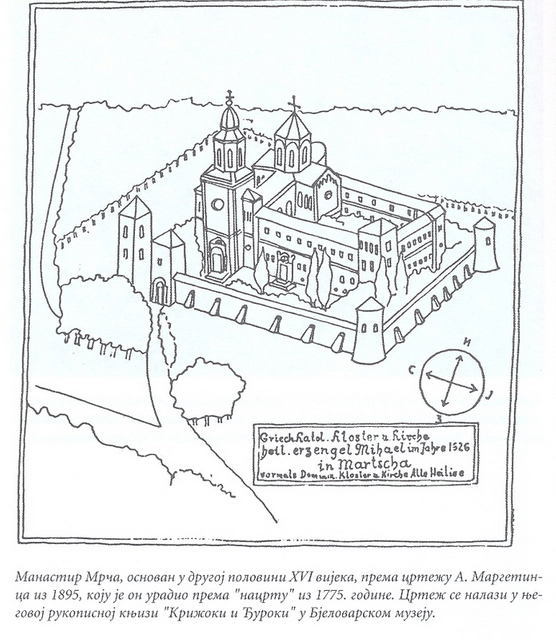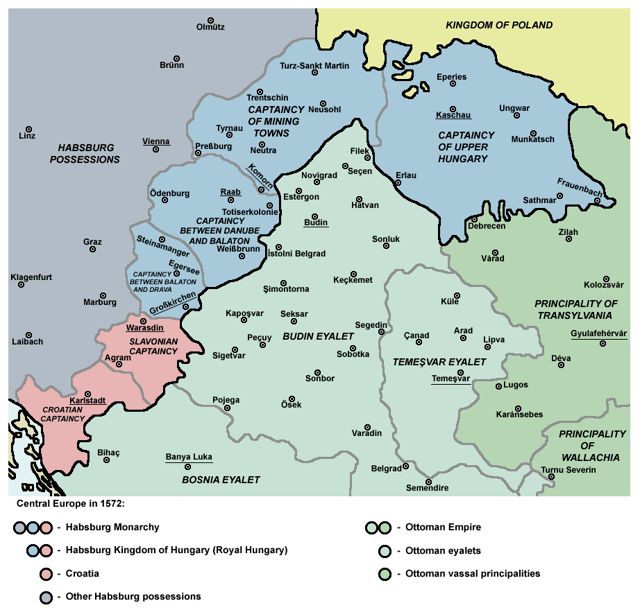Eparchy of Marča

Eparchy of Marča

Eparchy of Marča Марчанска епархија[1] | |
|---|---|
| Location | |
| Country | Habsburg Monarchy |
| Coordinates | 45°45′48″N 16°29′33″E [32] |
| Statistics | |
| Members | 60,000–72,000 |
| Information | |
| Rite | Eastern Catholic |
| Established | 21 November 1611 |
| Dissolved | 1753 |

Turkish conquests, and remains of Hungarian Kingdom by 1572, including upper Slavonia and Croatia
The Eparchy of Marča (Serbian Cyrillic: Марчанска епархија) refers to two historical ecclesiastical entities: Eastern Orthodox eparchy and Eastern Catholic vicariate. The term vas derived from the name of the monastery at Marča (today Stara Marča) near Ivanić-Grad, Habsburg Monarchy (present-day Zagreb County, Republic of Croatia).
Although Serbian Orthodox bishop Simeon Vratanja traveled to Rome in 1611 and formally accepted jurisdiction of the Pope over this bishopric, until 1670 Serb bishops continued to recognize the jurisdiction of the Serbian Patriarchate of Peć and struggled against conversion attempts by Roman Catholic bishops from Zagreb. This semi-union existed until the 1670 appointment of Pavle Zorčić as bishop. All Serb Orthodox clergy who objected to the union were arrested and sentenced to life in prison in Malta where they died. The bishopric eventually became the Eastern Catholic Eparchy of Križevci.[2]
Eparchy of Marča Марчанска епархија[1] | |
|---|---|
| Location | |
| Country | Habsburg Monarchy |
| Coordinates | 45°45′48″N 16°29′33″E [32] |
| Statistics | |
| Members | 60,000–72,000 |
| Information | |
| Rite | Eastern Catholic |
| Established | 21 November 1611 |
| Dissolved | 1753 |
Name
The name Marča was derived from the name of the nearby hill, Marča. Other names used for this bishopric include Svidnik (Svidnička eparhija), Vretanija (Vretanijska eparhija), and the "Uskok" bishopric.[3]
Background
After the Ottoman capture of Smederevo fortress in 1459 up to 200,000 Orthodox Christians moved into central Slavonia and territory of Srem which today belong to eastern Croatia.[4] At the beginning of the 16th century settlements of Orthodox Christians were also established in western Croatia.[5] In the first half of the 16th century Serbs settled Ottoman part of Slavonia while in the second part of the 16th century they moved to Austrian part of Slavonia.[6] In 1550 they established the Lepavina Monastery.[7] At the end of the 16th century a group of Serb Orthodox priests built a monastery dedicated to Saint Archangel Gabriel (Serbian: Манастир Светог Арханђела Гаврила) on the foundations (or near them)[8] of the deserted and destroyed Catholic Monastery of All Saints.[9]
Eparchy of Vretanija
In 1609 Serb Orthodox priests established Marča Monastery in Marča near Ivanić-Grad. In the same year the Marča Monastery became a seat of the Eparchy of Vretanija. This bishopric was the westernmost eparchy of the Serbian Patriarchate of Peć. Its name was derived from Vretanija (Serbian: Вретанијски остров) which was a part of the title of the Serbian Patriarch.[11] Its first bishop was Simeon Vratanja, appointed in 1609 by the Serbian Orthodox patriarch Jovan to the position of bishop of all Orthodox Serbs who settled to Croatia.[12] This appointment marked establishment of the Eparchy of Vretanja in 1609 according to historian Aleksa Ivić.[13]
Establishment as Eastern Catholic Church
Being under strong pressure from Croatian clergy and state officials to recognize the jurisdiction of the Pope, and to convert the population of his bishopric to Eastern Catholicism, Simeon Vratanja visited Pope Paul V in 1611 and recognized his jurisdiction and maybe the Union of Florence as well.[14] The strongest influence to his decision had Martin Dobrović, who convinced Simeon to recognize papal jurisdiction and to accept the Eastern Catholicism.[15][16]
In November 1611, the Pope appointed Simeon as bishop of Serbs of Slavonia, Croatia and Hungary. He also granted all estates that once belonged to the Catholic Monastery of All Saints to the Marča Monastery.[17] On 21 November 1611 Marča was established as an eparchy (bishopric) of the Eastern Catholic Church,[18] having around 60,000 believers.[1]
History
Period of semi-union (1611–1670)
Simeon continued to use Slavic language, Julian calendar and maintained connection with Serbian Patriarchate of Peć.[19]
In 1642 Benedikt Vinković wrote a letter to emperor Ferdinand III to write a report about "Vlachs" (Orthodox Serbs).[20] Vinković's activities were aimed against Serb bishop of Marča, Maksim Predojević, whom he reported to the Sacred Congregation for the Propagation of the Faith when Predojević refused to support the conversion of the population of his bishopric to Catholicism.[21] Vinković had intention to depose Predojević and appoint Rafael Levaković instead.[22]
In 1648 the king appointed Sava Stanislavić as bishop of the Bishopric of Marča, as wished by the Slavonian Serbs, although Petar Petretić, bishop of the Roman Catholic Archdiocese of Zagreb proposed another candidate.[23]
Period of union (1670–1753)
In 1754 around 17,000 Serb Uskoks rebelled in support of the Marča monastery, the seat of Uskok bishopric. The monastery was abandoned, as ordered by Empress Maria Theresa, and its treasury was looted.[26]
Bishops
The bishops of the Eparchy of Marča were:
Simeon Vratanja (1607–1629)
Maxim Predojević (1630–1642)
Gabrijel Predojević (1642–1644)
Vasilije Predojević (1644–1648)
Sava Stanislavić (1648–1661)
Gabrijel Mijakić (1663–1670)
Pavao Zorčić (1671–1685)
Marko Zorčić (1685–1688)
Isaija Popović (1689–1699)
Gabrijel Turčinović (1700–1707)
Grgur Jugović (1707–1709)
Rafael Marković (1710–1726)
Georg Vučinić (1727–1733)
Silvester Ivanović (1734–1735)
Teofil Pašić (1738–1746)
Gabrijel Palković (1751–1758)
Vasilije Božičković (1759–1777)